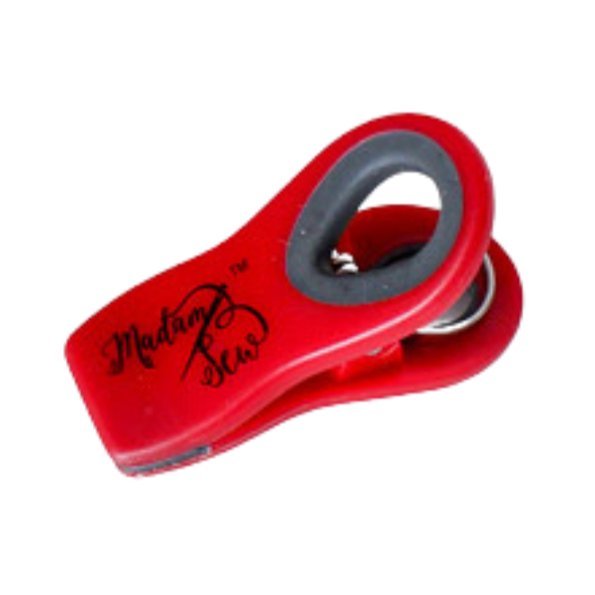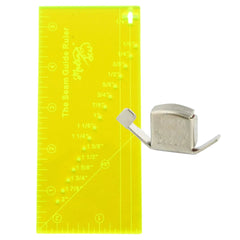Designing and Assembling a Quilt Top with Half-Square Triangle Blocks
Hello all!
In part 1 of this Quilted Pillow series, we learned how to make half-square triangle blocks, in part 2 it’s time to play with them to create our quilt top.
-
- ¼” quilting foot (#10 in the 32 Presser Foot Set) or 1/4" presser foot with guide (#17 in the set)
- Pins
- Masking tape and marker
- Sewing clips
- The 16 4½” half-square-triangle blocks you made in Part 1 of this tutorial
Deciding on a Design
Half-square triangles lend themselves to many, many different combinations. Candy stripes, flying geese, pinwheels, chevron, stars… the possibilities are almost endless
Start by lining up your blocks in rows of four, so that all the triangles are pointing in the same direction This will give your a clear view of your blocks and how your prints play together.
Now start playing! You can group your prints together or spread them randomly, turn your triangles in different directions to create different shapes.
Organizing for Sewing
Once you have settled on a design, we need to organize our blocks to ensure that we are going to sew them in the right order to create that exact design. This is a system that you can use for all your quilting projects that involve blocks, no matter how big or small. For the pillow we only have four rows with four blocks each, so it’s relatively easy to keep them straight, but for bigger projects it is really important to have a system.
First, mark the left square of each row with a number from 1 to 4 (because you have 4 rows), starting with the bottom one. Use a non-permanent method, but make sure that it is heat resistant (you don’t want to lose track of your rows once you press the seam allowances. I like to use a piece of masking tape and a sharpie.
Next, starting with the left (numbered) square, stack all blocks on each row. You will have four piles numbered from 1 to 4. Use clips to keep each stack together.
Now you can bring your stacks to the sewing machine to start assembling.
Joining Blocks
Since we stacked our blocks from left to right, we are going to be joining them in that order, meaning that we are always adding a block to the right of the last one. Therefore, pick up the first two blocks on your first stack, lay the first (numbered one) right side up, and lay the next one on top of it wrong side up.
Match the right seam allowances, and stitch a ¼” seam.
Open up the rectangle you just made so that it is right side up and lay the next square on the stack wrong side up on the right side. Again line up the seam allowances and stitch a ¼” seam.
Repeat with the last square on the stack so that you have a four-square rectangle.
Repeat this process with the remaining three stacks.
Pressing for Nested Seams
The first thing we need to do before joining our rows together is to press the seams for “nesting”. This just means that the seams in each row are all going to be pressed towards the same side, but adjacent rows are going to have the seams pressed in opposite directions. This ensures that the corners of your blocks will be perfectly aligned.
Press the seams of the first and third rows towards the right.
Press the seams of the second and fourth rows towards the left.
Pinning and Joining the Rows Together
Lay your rows in order, right side up, with the first one at the bottom.
Pick up the second row and lay it over the first one wrong side up.
Starting from either side, match the first two seams so that they are butted up against each other.
Now pin right through the middle of the nested seams. The pin should go in very easily, as you are going through the stitching, not the seam allowances. It’s worth it to take the time to get this right, so you can get those beautiful crisp corners on the first try.
Repeat with the rest of the seams on these two rows, and do the same with rows 3 and 4.
Bring the first two pinned rows to the machine, making sure that row 1 is at the bottom with the first square under the presser foot, and sew a ¼” seam removing the pins as you get to them.
Repeat with the other two rows. Now you have two sets of joined rows that you are going to join in the same manner. Lay rows 1 and 2 right side up, and rows 3 and 4 wrong side up, with the numbered blocks to the left. Lay 3 and 4 over 1 and 2, nestle and pin seams as before, and sew a ¼” seam allowance.
All that is left to do is to press the new seam allowances towards one side (it doesn’t matter which).
And that’s all there is to it! Next time we will make and quilt our sandwich and insert a zipper to finish the pillow cover!
Go to Part 3 of the Make a Quilted Pillow Tutorial
Happy Quilting!
Ana
Blogging for Madam Sew



















